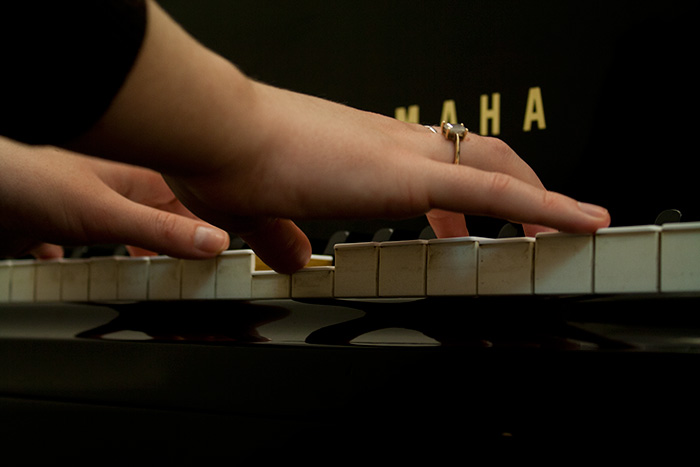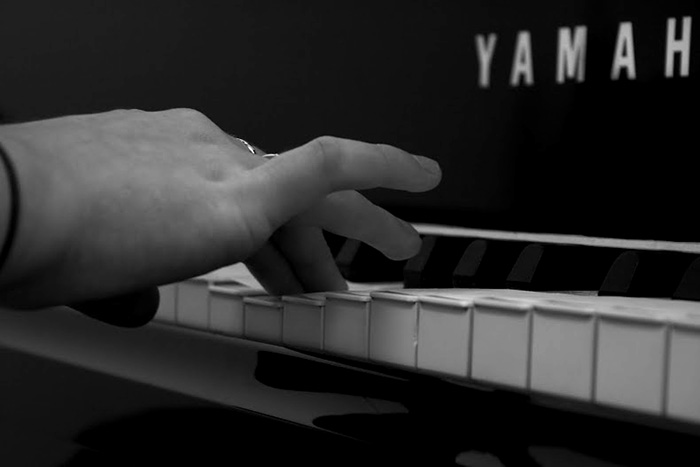Where surface meets skin:
Composing the skin/surface interface in compositions for piano
by Eleanor Cully
Through augmentation, modulation and opposition of traditional positions/points of pressure/contact in instrumental playing, I aim to forefront the skin/surface interface in my musical compositions. My work requires a performer to engage with the physical material of their instrument through touch-based performance practice. This short paper will present three recent piano works: everything located on the surface, skin, movements in two positions and often empty on the insides. I will discuss my compositional process for these pieces and outline various notated points of interface between keyboard surface and human skin.
In early 2014 I discovered the sculpture of Richard Deacon at the Tate Britain, London. Viewing Deacon’s large skeletal structures lead me to reflect upon his work in relation to the form and surface of the physical musical instrument. At this time I was writing a piece for piano solo, later named everything located on the surface, skin after this quote from Deacon: “the insides of my works are often empty. The surface, the skin is where everything is located” (Tate, 2014).
Rather like the relationship between Deacon’s active surfaces of bolts and glue, and his hollow open forms, I began to envisage the shell-like form of a piano in terms of a structural separation of keyboard surface from the resonating piano body. I locate the focal point of visual and tactile attraction upon this keyboard surface, as a kind of piano ‘skin’, rather than within the resonating centre. The keyboard surface does not require the player to have direct contact with the resonating object (the strings), and therefore the surface level of activity (the action of hand against keys) can be perceived in isolation. Thus, it was particularly appealing for me to contemplate composing the surface, as it is possible to divorce surface material and activity from any sonic activity within the piano body.


In both everything located on the surface, skin, and movements in two positions, single hand positions are adopted for the duration of the pieces, and the player is asked to remain in contact with the keyboard throughout. The resistance of a single fixed hand position enables me to compose through limitations; the position rather like a frame for restricted movement of keys/fingers within. The physical constraints of the hands have ramifications on my compositional parameters in the making of the work: dynamics, pitch relationships, and rhythms are limited in terms of what is physically possible in the hand position.
In the case of everything located on the surface-skin, the hand position is fixed in terms of its location, as the player inhabits a central area of the piano keyboard for the entire piece, with specific fingerings for this position notated. The position for this piece was created through an exploration of the sensation of fingertips placed over the cracks between white keys. In addition to the sensation of touch, this action was appealing to me on a visual level as I discovered a different way to inhabit the piano surface. Each finger within the position controls a dyad of two adjacent white keys, causing the hand to be positioned in an unconventional, but in no way grotesque manner. The hand span of a 15th is not an extreme space to inhabit with both hands, though what is perhaps unusual for a viewer is the visual experience of a larger surface area (two white keys) being activated by a small surface area (a single fingertip); a kind of augmentation of surface.
An alternative approach to fixed hand positions is taken in my piece movements in two positions:players perform with hand positions of their choice on any area of the keyboard, providing that all ten fingers are utilized on different notes. Taking this approach allows various outcomes of pitches for each player’s chosen positions. A short repeating pattern for the fingers is notated for the duration of the work. The player is asked to keep keys depressed after the first cycle of the pattern. Thereafter, the performer lifts and re-depresses keys in a manner alternative to that prescribed by classical technique: depressed keys are not released until the next time that key is played. The player also presses fingertips into the surface during the piece, causing them to unsuccessfully control certain hammer mechanisms. Throughout the piece, these varying levels of tension, together with notated variations in speed and dynamics result in fluctuations in rhythms and pitch cycles containing ghost notes: where the action takes place without the sound. Potentially, upon listening to a recording of this work, one might imagine the work arising from an unrelated notation and/or compositional process. Though the piece can be experienced as sound alone, the intention of the work is missed outside of the realm of performance. The physicality of the action unites the piano construction with the body of the performer as fingers and keys move together in sequence.
Related approaches can be witnessed in the work of performance artist Tom Marioni, who takes an action-based approach to composing patterns that come out of mapping physical extensions of his body against a surface. Marioni’s approach in Out of Body Free Hand Circle (2000-2014) http://www.tommarioni.com/wp-content/video/outofbody.mov, for example, which is itself a response to Leonardo da Vinci’s The Vitruvian Man (1485), delineates the limits of the body. In contrast to this, it is primarily the tactile as well as the limits of gesture in my own work that is sought as experience. As such, extreme gestures are avoided; the hands are placed in a central position with respect to the body and in somewhat comfortable positions.
Although identical sonic results may be derived from a variety of fingerings and positions in playing, I compose specific hand positions with a view to the hand position being as much ‘the work’ as the sound. In these works, as in all music, the performer has a different experience of the music than the listening audience. However, unlike most music, here this experience is the subject of the composition itself. The performer experiences all of the musical material beneath their fingertips within the fixed hand position at any one time during the piece. Thus, the tactile experience of interface between the skin of the fingers and the surface of the instrument is foregrounded.
In addition to the use of fixed hand positions, other works of mine utilise different techniques for limiting performance gesture. Masking tape is an often-utilised material in both my visual work, as well as in my musical composition, where it is used for marking out sections upon instruments. In my third piano piece often empty on the insides, a piano’s white keys are covered with three overlapping strips of masking tape and these white keys are the material for the entire piece; my structural goal to have played every white key by the end of the piece through the procedure of unsticking the tape.
I began to experiment with the sonic properties of tape in 2014 after experiencing Edward Henderson’s Tape Piece in which players slowly unravel a reel of sellotape in a space. In my piece often empty on the insides, strips of tape unpeel against each other and against other adjacent white keys when a key is depressed. Sometimes, when the tape has been loosened on the surface, a depression may cause the internal hammer mechanism to hit the string, therefore producing a pitch. A single key is more likely to activate a pitch if it is between two, or adjacent to a single previously depressed key/s. Audible pitches are dependent upon the weight of the key depression, which depends upon the touch of the player. The piece directs the player to gently press down on one of three layers of tape of their choice, resulting in varying tape sounds and differing likelihoods of pitch activation. The order of the keys was decided upon visually and then notated to ensure that only surface (masking tape) sounds are heard at the beginning. This procedure ensured that the surface noise bands of masking tape persisted for as long as possible before giving way to pitched material.


In this third piano piece, the masking tape acts as an interface between the contact of human skin and the instrument surface. In this way it represents a visual, sculptural and audible skin for the piano; a kind of second/faux skin. Perhaps this faux skin draws me closer to embracing a physical-tactile relationship between both human and instrument skin. I am interested to further develop new material ‘skins’ for instruments that facilitate sound through tactile interface.
Edward Henderson 2014, March, 28th Tape Piece [Video file]. Retrieved from:
https://www.youtube.com/watch?v=y0RngEeib1g
Marioni, T. (2009). Video: action drawings [Video]. Retrieved from
http://www.tommarioni.com/wp-content/video/outofbody.mov
Tate 2014, February, 6th Tateshots: Richard Deacon [Video file]. Retrieved from
https://www.youtube.com/watch?v=DIqBdDApU04
The University of Chicago 2012, March, 28th Tom Marioni: The Act of Drinking Beer
[Video file]. Retrieved from https://www.youtube.com/watch?v=6ieR8cCoGQY
